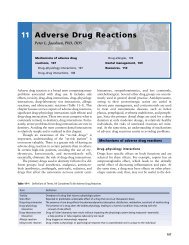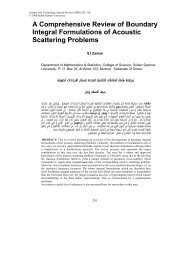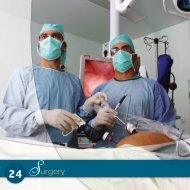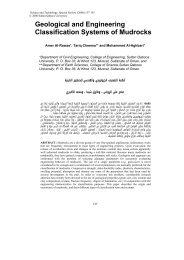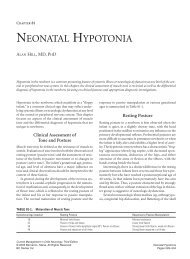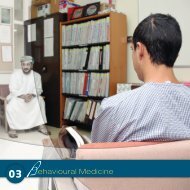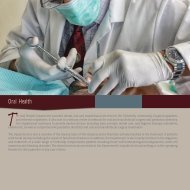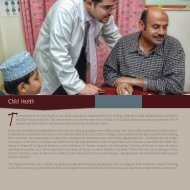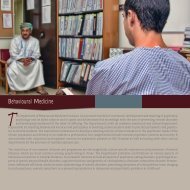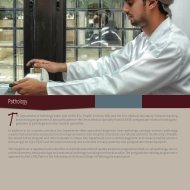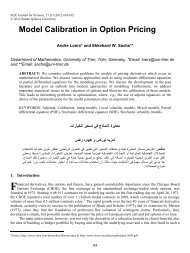popular press has sensationalized these reports. While there is evidence that sperm numbershave changed, one must be cautious, remembering that both andrology and laboratorymethodology have changed over the last half century. Are the observed changes a reflectionof study participants and/or methodology, and are they real? 100-102 Related to this currentcontroversy are reports that this decline is due to male offspring being exposed in utero toestrogenic compounds from our environment. While exposure to estrogenic (and otherhormonal) compounds in utero can have negative effects on sperm production, 103 a directcause and effect have not been shown between estrogenic compounds and a decline of spermnumbers in the human race. This is an interesting hypothesis that needs much more research.4 SUMMARYThe male reproductive system is susceptible to toxic insult that results in decreasedfecundity and/or an increase in adverse pregnancy. Each year, several hundred new compoundsare added to the 70 thousand compounds and 4 million mixtures already in commercialuse, 104 suggesting that there is a need to evaluate the effects that a man’s workplaceand environment has on his fecundity. There are several methods for evaluating male fecundity,often requiring a large research team and complex laboratory assessments. While the problemsin conducting such a study may seem unsurmountable, a team approach has allowed thisresearch to be successful. 91REFERENCES1. Sokol, R. Z., Endocrine evaluations in the assessment of male reproductive hazards, Reprod. Toxicol., 2,217–222, 1988.2. Schrader, S. M., Turner, T. W., Breitenstein, M. J., and Simon, S. D., Measurement of male reproductivehormones for field studies, J. Occup. Med., 35, 574–576, 1993.3. Bardin, C. W., Pituitary-testicular axis, in <strong>Reproductive</strong> Endocrinology, Yen, S. S. C. and Jaffe, R. B., Eds.,W.B. Saunders, Philadelphia, 1986, pp. 177–199.4. Raid-Fahmy, D., Read, G. F., Walker, R. F., and Griffiths, K., Steroids in saliva for assessing endocrinefunction, Endocrinol. Rev., 3, 367–395, 1982.5. Apostoli, P., Romeo, L., Peroni, E., Ferioli, A., Ferrari, S., Pasini, F., and Aprili, F., Steroid hormone sulphationin lead workers, Br. J. Ind. Med., 46, 204–208, 1989.6. Plant, T. M., Puberty in primates, in The Physiology of Reproduction, Knobil, E. and Neill, J. D., Eds., RavenPress, New York, 1988, pp. 1763–1788.7. NIOSH, Collecting a Semen Sample, National Institute for Occupational Safety and Health, Cincinnati, OH,1986.8. Eliasson, R. and Treichl, L., Supravital staining of human spermatozoa, Fertil. Steril., 22, 134–137, 1971.9. Jeyendran, R. S., Van den Ven, H. H., Perez-Palaez, M., Crabo, B. G., and Zaneveld, L. J. D., Developmentof an assay to assess the functional integrity of the human sperm membrane and its relationship to othersemen characteristics, J. Reprod. Fertil., 70, 219–228, 1984.10. Schrader, S. M., Platek, S. F., Zaneveld, L. J. D., Perez-Palaez, M., and Jeyendran, R. S., Sperm viability: acomparison of analytical methods, Andrologia, 18, 530–538, 1986.11. MacLeod, J., Semen quality in 1000 men of known fertility and in 800 cases of infertile marriage, Fertil.Steril., 2, 115–139, 1951.12. Freund, M., Standards for the rating of human sperm morphology, Int. J. Fertil., 11, 97–180, 1966.13. Fredricson, B., Morphologic evaluation of spermatozoa in different laboratories, Andrologia, 11, 57–61, 1979.14. Hanke, L. J., Comparison of Laboratories Conducting Sperm Morphology, Report TA78-28, National Institutefor Occupational Safety and Health, Cincinnati, OH, 1981.15. Schmassmann, A., Mikuz, G., Bartsch, G., and Rohr, H., Quantification of human sperm morphology andmotility by means of semi-automatic image analysis systems, Microscopica Acta, 82, 163–178, 1979.16. Katz, D. F., Overstreet, J. W., and Pelprey, R. J., Integrated assessment of the motility, morphology andmorphometry of human spermatozoa, INSERM, 103, 97–100, 1981.© 1999 by CRC Press LLC
17. Schrader, S. M., Turner, T. W., Hardin, B. D., Niemeier, R. W., and Burg, J. R., Morphometric analysis ofhuman spermatozoa, J. Androl., 5, 22, 1984.18. Jagoe, J. R., Washbrook, N. P., and Hudson, E. A., Morphometry of spermatozoa using semiautomatic imageanalysis, J. Clin. Pathol., l39, 1347–1352, 1986.19. DeStefano, F., Annest, J. L., Kresnow, M. J., Flock, M. L., and Schrader, S. M., Automated semen analysisin large epidemiologic studies, J. Androl., 8, 24, 1987.20. Turner, T. W., Schrader, S. M., and Simon, S. D., Sperm head morphometry as measured by three differentcomputer systems, J. Androl., 9, 45, 1988.21. Moruzzim J. F., Wyrobek, A. J., Mayall, B. H., and Gledhill, B. L., Quantification classification of humansperm morphology by CASA, Fertil. Steril., 50, 142–152, 1988.22. Schrader, S. M., Ratcliffe, J. M., Turner, T. W., and Hornung, R. W., The use of new field methods of semenanalysis in the study of occupational hazards to reproduction: the example of ethylene dibromide, J. Occup.Med., 29, 963–966, 1987.23. Zukerman, Z., Rodriguez-Rigau, L. J., Weiss, D. B., Chowdhury, A. K., Smith, K. D., and Steinberger, E.,Quantitative analysis of the seminiferous epithelium in human testicular biopsies, and the relation of spermatogenesisto sperm density, Fertil. Steril., 30, 448–455, 1978.24. Whorton, D., Milby, T. H., Krauss, R. M., and Stubbs, H. A., Testicular function in DBCP-exposed pesticideworkers, J. Occup. Med., 21, 161–166, 1979.25. Potashnik, G. and Abeliovich, D., Chromosomal analysis and health status of children conceived to menduring or following dibromochloropropane-induced spermatogenic suppression, Andrologia, 17, 291–296,1985.26. Ratcliffe, J. M., Schrader, S. M., Steenland, K., Clapp, D. E., Turner, T., and Hornung, R. W., Semen qualityin papaya workers with long term exposure to ethylene dibromide, Br. J. Ind. Med., 44, 317–326, 1987.27. Schrader, S. M. and Kanitiz, M. H., Occupational hazards to male reproduction, in State of the Art Reviewsin Occupational Medicine: <strong>Reproductive</strong> Hazards, Gold, E., Schenker, M., and Lasley, B., Eds., Hanley &Belfus, Philadelphia, 1994, pp. 405–414.28. Olshan, A. F. and Mattison, D. R., <strong>Male</strong> Mediated Development <strong>Toxicity</strong>, Plenum Press, New York, 1994.29. Martin, R. H., A detailed method for obtaining preparations of human sperm chromosomes, Cytogenet. CellGenet., 35, 252–256, 1983.30. Martin, R. H., Detection of genetic damage in human sperm, Reprod. Toxicol., 7(Suppl. 1), 47–52, 1993.31. Estop, A. M., Marquez, C., Munne, S., Navarro, J., Cieply, K., Vankirk, V., Martorell, M. R., Benet, J., andTemplado, C., An analysis of human sperm chromosome breakpoints, Am. J. Human Genet., 56, 452–460,1995.32. Evenson, D. P., Flow cytometry of acridine orange-stained sperm is a rapid and practical method formonitoring occupational exposure to genotoxicants, in Monitoring Occupational Genotoxicity, Sorsa, M. andNorppa, H., Eds., Alan R. Liss, New York, 1986, pp. 121–132.33. Evenson, D. P., Jost. L. K., Baer, R. K., Turner, T. W., and Schrader, S. M., Individuality of DNA denaturationpatterns in human sperm as measured by the sperm chromatin structure assay, Reprod. Toxicol., 5(2), 115–125,1991.34. Spano, M. and Evenson, D. P., Flow cytometric studies in reproductive toxicology, in New Horizons inBiological Dosimetry, Gledhill, B. L. and Mauro, F., Eds., Wiley-Liss, New York, 1991, pp. 497–511.35. Holmes, J. M. and Martin, R. H., Aneuploidy detection in human sperm nuclei usisng fluorescence in situhybridization, Human Genet., 91, 20–24, 1993.36. Wyrobek, A. J., Robbins, W. A., Mehraein, Y., Pinkel, D., and Weier, H. U., Detection of sex chromosomalaneuploidies X-X, Y-Y, and X-Y in human sperm using two-chromosome fluorescence in situ hybridization,Am. J. Med. Genet., 53, 1–7, 1994.37. Bischoff, F. Z., Nguyen, D. D., Burt, K. J., and Shaffer, L. G., Estimates of aneuploidy using multicolorfluorescence in situ hybridization on human sperm, Cytogenet. Cell Genet., 66, 237–243, 1994.38. Stachel, B., Dougherty, R. C., Lahl, U., Schlosser, M., and Zeschmar, B., Toxic environmental chemicals inhuman semen: analytical method and case studies, Andrologia, 21, 282–291, 1989.39. Zikarge, A., Cross-Sectional Study of Ethylene Dibromide-Induced Alterations of Seminal Plasma Biochemistryas a Function of Post-Testicular <strong>Toxicity</strong> with Relationships to Some Indices of Semen Analysis andEndocrine Profile, Dissertation to the University of Texas Health Science Center, Houston, TX, 1986.40. Mann, T. and Lutwak-Mann, C., Passage of chemicals into human and animal semen: mechanisms andsignificance, CRC Crit. Rev. Toxicol., 11, 1–14, 1982.41. Schrader, S. M., Turner, T. W., and Ratcliffe, J. M., The effects of ethylene dibromide on semen quality: acomparison of short term and chronic exposure, Reprod. Toxicol., 2, 191–198, 1988.42. Yazigi, R. A., Odem, R. R., and Polakoski, K. L., Demonstration of specific binding of cocaine to humanspermatozoa, J. Am. Med. Assoc., 266, 1956–1959, 1991.43. Aitkin, R. J., Development of in vitro tests of human sperm function: a diagnostic toll and model system fortoxicological analyses, Toxic. In Vitro, 4, 560–569, 1990.44. Katz, D. F., Overstreet, J. W., and Hanson, F. W., A new quantitative test for sperm penetration into cervicalmucus, Fertil. Steril., 33, 179–186, 1980.© 1999 by CRC Press LLC





